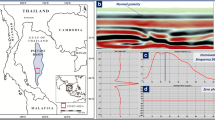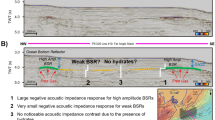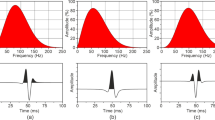Abstract
The bottom simulating reflector (BSR), the boundary between the gas hydrate and the free gas zone, is considered to be the most common evidence in seismic data analysis for gas hydrate exploration. Multiple seismic attribute analyses of reflectivity and acoustic impedance from the post-stack deconvolution and complex analysis of instantaneous attribute properties including the amplitude envelope, instantaneous frequency, phase, and first derivative of the amplitude of seismic data have been used to effectively confirm the existence of a BSR as the base of gas hydrate stability zone. In this paper, we consider individual seismic attribute analysis and integrate the results of those attributes to locate the position of the BSR. The outputs from conventional seismic data processing of the gas hydrate data set in the Ulleung Basin were used as inputs for multiple analyses. Applying multiple attribute analyses to the individual seismic traces showed that the identical anomalies found in two-way travel time (TWT) between 3.1 and 3.2 s from the results of complex analyses and l 1 norm deconvolution indicated the location of the BSR.









Similar content being viewed by others
References
Barnes AE (2007) A tutorial on complex seismic trace analyses. Geophysics 72(6):w33–w43. doi:10.1190/1.2785048
Barrodole, Zala CA, Chapman NR (1984) Comparison of the l 1 and l 2 norm applied to one at time spike extraction from seismic traces. Geophysics 41(11):2048–2052. doi:10.1190/1.1441616
Beauchamp B (2004) Natural gas hydrate: myths, facts and issues. J C R Geoscience 336:751–765. doi:10.1016/j.crte.2004.04.003
Bouriak S, Vanneste M, Saoutkine A (2000) Inferred gas hydrate and clay diapirs near Storegga slide on the southern edge of the Voring plateau, offshore Norway. Mar Geol 163:125–148. doi:10.1016/S0025-3227(99)00115-2
Chapman NR, Gettrust JF, Walia R, Hannay D, Spence GD, Wood WT, Hyndman RD (2002) High resolution, deep-towed, multi channel seismic survey of deep sea gas hydrate off western Canada. Geophysics 67:1038–1047. doi:10.1190/1.1500364
Davies EE, Hyndman RD and Villinger H (1990) Rates of fluid expulsion across the northern Cascadia accretionary prism: Constrain from heat flow and multiple seismic reflection data. Journal of Geophysical Research 95:8869–8889
Debeye HWJ, Van Riel P (1989) lp norm deconvolution. Geophys Prospect 38:381–403. doi:10.1111/j.1365-2478.1990.tb01852.x
Ganguly R, Spence GD, Chapman NR, Hyndman (2000) Heat flow variations from bottom simulating reflectors on the Cascadia margin. Mar Geol 164:53–68. doi:10.1016/S0025-3227(99)00127-9
Gardner GM, Shor AN, Jung WY (1998) Acoustic imagery evidence for methane hydrates in the Ulleung Basin. Mar Geophys Res 20:495–503. doi:10.1023/A:1004716700055
Horozal S, Lee GH, Yi YB, Yoo DG, Park KP, Lee HY, Kim W, Kim HJ, Lee K (2009) Seismic indicators of gas hydrate associated gas in Ulleung Basin, East sea (Japan sea) and implication of heat flows derived from depths of bottom simulating reflecter. Mar Geol 258(2009):126–138. doi:10.1016/j.crte.2004.04.003
Hyndman RD, Spence GD (1992) A seismic study of methane hydrate marine bottom simulating reflectors. J Geophys Res 95(B5):6683–6698
Hyndman RD, Wang K, Yuan T, Spence GD (1993) Tectonic sediment thickening: fluid expulsion and the thermal regime of subduction zone acccretionary prisms: the Cascadia margin off Vancouver island. J Geophys Res 98:21865–21876
Hyndmand RD, Spence GD, Chapman R, Riedel M, Edward RN (2001) Geophysical study of marine gas hydrate in Northern Cascadia. AGU Geophys Monogr 124:273–295
Jang S, Suh S, Ryu BJ (2005) Complex analysis for gas hydrate seismic data. Korea Soc Geosystem Eng 42:180–190
Kuster GT, Toksoz MN (1974) Velocity and attenuation of seismic waves in two phase media, 1, Theoretical formulation. Geophysics 39:587–606. doi:10.1190/1.1440450
Lee MW, Hutchinson RD, Collett TS, Dillon WP (1996) Seismic velocity for hydrate-bearing sediments using weight equation. J Geophys Res 101(B9):347–358. doi:10.1029/96JB01886
Lee JH, Baek YS, Ryu BJ, Riedel R (2005) A seismic survey to detect gas hydrate in the East Sea of Korea. Mar Geophys Res 26:51–59. doi:10.1007/s11001-005-6975-4
Levy S, Fullagar PK (1981) Reconstruction of a sparse spike train from a portion of its spectrum and application to high resolution deconvolution. Geophysics 46:1235–1243. doi:10.1190/1.1441261
Moore JC, Judge AS (1998) Processing of ODP, Initial reports, collect station. Ocean drilling program, TX
Oldenburg DW, Scheuer T, Levy S (1983) Recovery of the acoustic impedance from reflection seismograms. Geophysics 48:1318–1337. doi:10.1190/1.1441413
Peterson RA, Fillipone WR, Coker FB (1955) The synthesis of seismograms from well log data. Geophysics 20:516–538. doi:10.1190/1.1438155
Riedel M, Spence GD, Chapman NR, Hyndman RD (2002) Seismic investigation of a vent field associate with gas hydrate offshore Vancouter island. J Geophys Res 107(B9):EPM 5-1–EPM 5-16. doi:10.1029/2001JB000269
Robinson EA and Osman MO (1996) Deconvolution 2. Geophysics reprint series No. 17. Society of Exploration Geophysics, 632 pp
Ryu BJ, Riedel M, Kim JH, Hyndman RD, Lee YJ, Chung BH, Kim JS (2009) Gas hydrate in the western deep water Ulleung Basin, east sea of Korea. Mar Mar Geol 26:1483–1498. doi:10.1016/j.marpetgeo.2009.02.2004
Sacchi DM, Velis DR, Cominguez AH (1994) Minimum entropy deconvolution with frequency domain constraints. Geophysics 59:938–945. doi:10.1190/1.1443653
Sloan ED (1998) Clathrate hydrate of natural gases. Mark darker. Inc., 705 p
Suh S (2005) GEOBIT-2.10.14, the seismic data processing tools. KIGAM. Unpublished document
Taner MT (2000) Attributes revisited. Technical paper in rock solid images. Available at http://www.rocksolidimage.com/pdf/attrib_revisited.htm
Taner MT, Koehler F, Sheriff RE (1979) Complex seismic trace analysis. Geophysics 44:1041–1063. doi:10.1190/1.1440994
Walker C, Ulrych TJ (1983) Autoregressive modeling of the acoustic impedance. Geophysics 48:1338–1350. doi:10.1190/1.1441414
Waters KH (1978) Reflection seismology, a tool for energy resource exploration. John Wiley and Sons, New York, 377 pp
Yilmaz OZ (2001) Seismic data analysis. Society of Exploration Geophysics, 2027 pp
Yuan T, Spence GD, Hyndman RD, Minshull TA, Singh SC (1999) Seismic velocity studies of a gas hydrate bottom-simulating reflector on the northern Cascadia continental margin: amplitude modelling and full waveform inversion. J Geophys Res 104:1179–1191. doi:10.1029/1998JB90020
Acknowledgments
This research was supported by the Contribution Project of the Korea Institute of Geoscience and Mineral resources (KIGAM) funded by the Ministry of Knowledge Economy of Korea.
Author information
Authors and Affiliations
Corresponding author
Appendices
Appendix A: Seismic complex analyses
The analytic seismic trace is given as follows:
where f(t) is the real part corresponding to the recorded seismic data and g(t) the imaginary part of the complex trace, is the Hilbert transform of f(t) that is defined as follows:
where τ is delay time.
Furthermore, we define E(t), θ(t), and ω(t) as the amplitude envelope, instantaneous phase, and frequency, respectively. The total instantaneous energy or amplitude envelope is computed as follows:
As given in Eq. A-3, the envelope is dependent on the phase, and relates to the acoustic impedance contrast or reflectivity. This attribute can be used as an effective discriminator for several characteristics such as possible gas accumulation, major changes of lithology and depositional environments.
The first derivative of the amplitude envelope represents the variation of the energy of the reflected events. It also represents the energy loss. The lower ratio indicates greater energy loss effects. The first derivative of the amplitude envelope is calculated as follows:
where * denotes the convolution operator and dif(f(t)) is the differentiation operator.
The second derivative of amplitude envelope \( {\frac{{d^{2} E(t)}}{{dt^{2} }}} \) gives the measure of the sharpness of the envelope peak, and could be used as the principle attribute to indicate sharp changes of lithology, as well as a change in the depositional environment, even when the corresponding envelope amplitude is low.
The instantaneous phase is determined from the complex form of the seismic trace given in Eq. A-1 as follows:
The information in the instantaneous phase is dependent on the amplitude, and relates to the propagation phase of seismic wave front. The phase attribute can be effectively used as discriminator of geometrical shape classification.
Instantaneous frequency is defined as
This equation shows that the nature of instantaneous frequency is phase variation with time, which is different from the frequency in a Fourier transform. As seen in Eq. A-6 the instantaneous frequency is negative whenever \( g(x,t){\frac{df(x,t)}{dt}} - f(x,t){\frac{dg(x,t)}{dt}} \) is negative. The instantaneous frequency can be related to wave propagation and results from changes in the depositional environment, as well as being a direct hydrocarbon indicator because of a low frequency anomaly.
Appendix B: l 1 norm deconvolution
The seismic trace x(t) is created by convolving the reflectivity r(t) and source wavelet s(t), and the additive noise term n(t) as given
where * is denoted for the convolution operator.
If the subsurface is assumed to be flat, the reflectivity function will be zero everywhere except at those times τ k that correspond to the two-way travel time to the kth layer. The reflectivity function could be expressed as Delta function as given in Eq. B-2:
where NL is the total number of layers and r k is the reflectivity coefficient at the interface between the kth and the k + 1th layers. The acoustic impedance in the kth layer is defined as follows:
where v k and ρ k is the velocity and density of the kth layer, respectively. The reflectivity coefficient at the base of the kth layer depends upon the acoustic impedance contrast and is given by the following:
Rearrangement of Eq. B-4 yields
The relationship between acoustic impedance and reflectivity function is approximated as (Peterson et al. 1955; Waters 1978)
The solution of ordinary derivative Eq. B-6 is given as
where ξ(0) = ξ 1 is the surface impedance. We define
So that, from Eq. B-7 we have
The linear program approach is used to extract information about r(t) is used only in “appraisal” methods whose goals were to recover unique information about the reflectivity in the form of averages < r(t) > = r(t) * a(t), where a(t) is the averaging function (Oldenburg et al. 1983). The alternative way of extracting information about the reflectivity function is to write the continuous form of Eq. B-1.
Equation (B-10) can be used to construct acceptable models, that is, function r(t), which reproduces the data to within an error justified by its accuracy. The primary obstacle for this approach is non-uniqueness. There are a finite number of acceptable modes, and they will not necessarily be similar. This non-uniqueness must be reduced if construction methods are to be useful, and in order to do this, more information must be supplied. One piece of information comes from the assumption that the Earth structure is adequately represented by a sequence of homogeneous layers. With that hypothesis, the reflectivity function could be expressed in mathematical form, as given in Eq. B-2. The usefulness of Eq. B-2 was discussed in more detail by Oldenburg et al. (1983). There are many ways to achieve the reasonable reflectivity in the form of Eq. B-10, and one of very important fact for this issue is to assume the source wavelet is known or well predicted. Because the deconvolution is considered as inversion technique, the corresponding solution is to iteratively minimize the objective function, that is defined by some norms in which the l 2 norm is mostly used. The comparison between two algorithms based on l 1 and l 2 norm given by Barrodole et al. (1984) states out that the l 1 norm procedures are shown to exhibit different characteristics which are often desirable, and the results are generally superior to those of the l 2 norm procedures for one at a time spike extraction.
The extraction of reflectivity function could use the l 1 norm, consequently minimizing as
or
Either ϕ 1 or ϕ 2 can be minimized, but the minimization of ϕ 2 leads to particularly simple results. Using the definition of η(t) and Eq. B-9, we obtain
Thus, minimizing ϕ 2 is equivalent to minimizing
The time discrete form of reflectivity function, r(t) can be expressed as
where N is the number of time samples and Δ is the time interval. The substitution of Eq. B-15 into Eq. B-14 yields
as an objective function to be minimized. The minimization of Eq. B-16 is precisely the problem dealt with by Levy and Fullagar (1981). Their solution is briefly outlined here. Taking the Fourier transform of Eq. B-10 and separating it into real and imaginary parts, we have
The most straightforward estimate of the Fourier transform of reflectivity R j is from the Fourier transform of seismic trace (X) and source wavelet (W), which is:
In fact the seismic trace is contaminated by noise, and, in practice, the source wavelet can only be approximated. Nevertheless, errors for the real and imaginary portions of R j can often be estimated, and, hence, \( \text{Re} \{ R_{j} \} \)and \( \text{Im} \{ R_{j} \} \) can be admitted as a constraint in the linear programming algorithm by requiring
where δ j is the standard deviation of \( \text{Re} \{ R_{j} \} \) or \( \text{Im} \{ R_{j} \} \) and α is the factor determining the goodness of fit. The detailed linear programming is discussed by Oldenburg et al. (1983).
Rights and permissions
About this article
Cite this article
Hien, D.H., Jang, S. & Kim, Y. Multiple seismic attribute analyses for determination of bottom simulating reflector of gas hydrate seismic data in the Ulleung Basin of Korea. Mar Geophys Res 31, 121–132 (2010). https://doi.org/10.1007/s11001-010-9081-1
Received:
Accepted:
Published:
Issue Date:
DOI: https://doi.org/10.1007/s11001-010-9081-1




